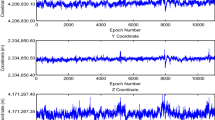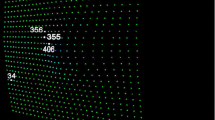Abstract
The article deals with the possibilities of the automatic detection of outliers during the processing of accurate surveying measurements which are assessed by the least squares adjustment. These are classical terrestrial measurements obtained during the survey of high precision spatial geodetic networks. The authors use robust M-estimators for the automatic detection of outlying measurements. Robust adjustment is combined with the method of the assessment adjusted measurements’ residuals. In the article, the authors focus on the description of the detection method and its testing. The testing concept consists in the determination of the efficiency of the detection of outliers of experimental measurements in a model spatial geodetic network. By means of a computer pseudorandom number generator, a model of ideally created measurements is generated in the first phase of experimental testing. This model is repeatedly contaminated with varying numbers of differently outlying measurements, and the automatic detection method is applied during their subsequent processing. The resulting detected measurements are compared against contaminated input outliers and the actual efficiency of the detection method is identified.





Similar content being viewed by others
References
Akter S, Khan MHA (2010) Multiple-case outlier detection in multiple linear regression model using quantum-inspired evolutionary algorithm. J Comput 5(12):1779–1788
Axelson P (1996) Outlier detection in relative orientation: removing or adding observations. In: Kraus K, Waldhäusl P (eds) XVIIIth ISPRS congress-technical commission III: theory and algorithms, international archives of photogrammetry and remote sensing, vol XXXI, pp 42–47
Baarda W (1968) A testing procedure for use in geodetic networks, vol 2. Netherlands Geodetic Commission, Delft
Baselga S (2011) Exhaustive search procedure for multiple outlier detection. Acta Geod Geophys Hung 46(4):401–416
Benning W (1995) Vergleich dreier Lp-Schaetzer zur Fehlersuche in hybriden Lagenetzen. Z Vermess 120(12):606–617
Berné JL, Baselga S (2005) Robust estimation in geodetic networks. Física de la Tierra 17:7–22
Erenoglu RC, Hekimoglu S (2010) Efficiency of robust methods and tests for outliers for geodetic adjustment models. Acta Geod Geophys Hung 45(4):426–439
Fischler MA, Bolles RC (1981) Random sample consensus: a paradigm for model fitting with applications to image analysis and automated cartography. Commun ACM 24(6):381–395
Gašincová S, Gašinec J (2010) Adjustment of positional geodetic networks by unconventional estimations. Acta Montan Slov 15(1):71–85
Gökalp E, Güngör O, Boz Y (2008) Evaluation of different outlier detection methods for gps networks. Sensors 8(11):7344–7358
Gullu M, Yilmaz I (2010) Outlier detection for geodetic nets using adaline learning algorithm. Sci Res Essays 5(5):440–447
Harvey BR (1993) Survey network adjustments by the L1 method. Aust J Geod Photogramm Surv 59:39–52
Hekimoglu S (2005) Do robust methods identify outliers more reliably than conventional tests for outliers? Z Vermess 3:174–180
Hekimoglu S, Koch KR (1999) How can reliability of the robust methods be measured?, vol 1. In: Third Turkish-German Joint Geodetic Days, pp 179–196
Huber P (1964) Robust estimation of a location parameter. Ann Math Stat 35(1):73–101
Jäger R, Müller T, Saler H, Schwäble R (2005) Klassische und robuste Ausgleichungsverfahren: Ein Leitfaden für Ausbildung und Praxis von Geodäten und Geoinformatikern. Herbert Wichmann Verlag, Heidelberg
Knight N, Wang J (2009) A comparison of outlier detection procedures and robust estimation methods in gps positioning. J Navig 62:699–709
Koch KR (1996) Robuste parameterschaetzung. Allg Vermess Nachr 103:1–18
Koch KR (1999) Parameter estimation and hypothesis testing in linear models. Springer, Berlin
Pope AJ (1976) The statistics of residuals and the outlier detection of outliers. NOAA Tech Rep 65(1):256
Rangelova E, Fotopoulos G, Sideris MG (2009) On the use of iterative re-weighting least-squares and outlier detection for empirically modelling rates of vertical displacement. J Geod 83(6):523–535
Sisman Y (2010) Outlier measurement analysis with the robust estimation. Sci Res Essays 5(7):668–678
Sisman Y, Dilaver A, Bektas S (2012) Outlier detection in 3D coordinate transformation with fuzzy logic. Acta Montan Slov 17(1):1–8
Xu PL (1989) On robust estimation with correlated observations. Bull Geod 63:237–252
Xu PL (1993) Consequences of constant parameters and confidence intervals of robust estimation. Boll Geod Sci Affin 52(3):231–249
Yang Y (1994) Robust estimation for dependent observations. Manuscr Geod 19:10–17
Youcai H (1995) On the design of estimators with high breakdown points for outlier identification in triangulation networks. Bull Geod 69:292–299
Acknowledgments
The article was written with support from the internal grant of Czech Technical University in Prague: SGS13/059/OHK1/1T/11 “Optimization of acquisition and processing of 3D data for purpose of engineering surveying”.
Author information
Authors and Affiliations
Corresponding author
Rights and permissions
About this article
Cite this article
Třasák, P., Štroner, M. Outlier detection efficiency in the high precision geodetic network adjustment. Acta Geod Geophys 49, 161–175 (2014). https://doi.org/10.1007/s40328-014-0045-9
Received:
Accepted:
Published:
Issue Date:
DOI: https://doi.org/10.1007/s40328-014-0045-9




